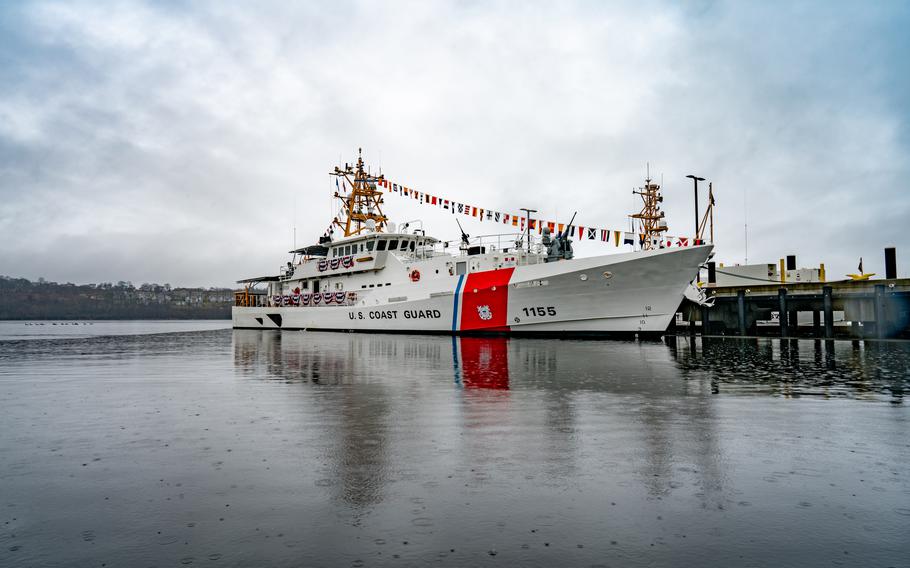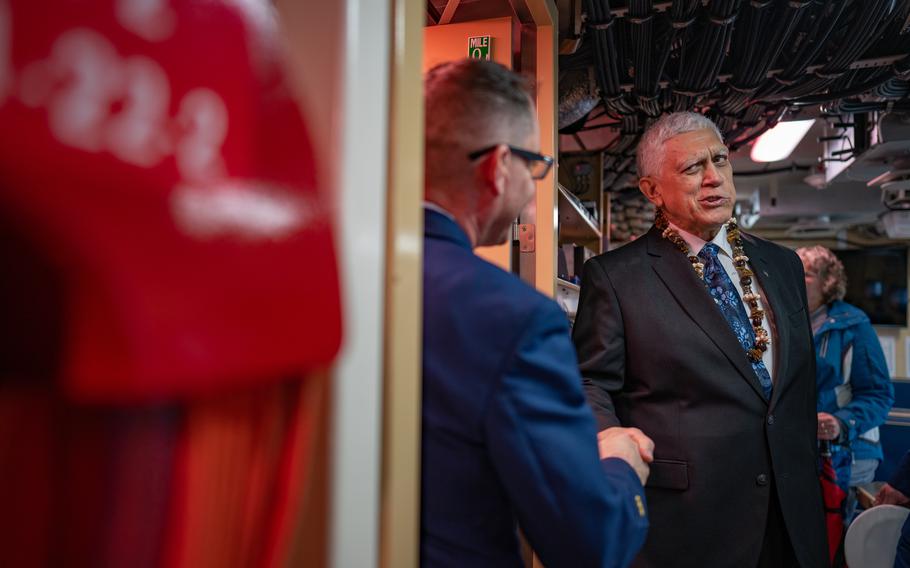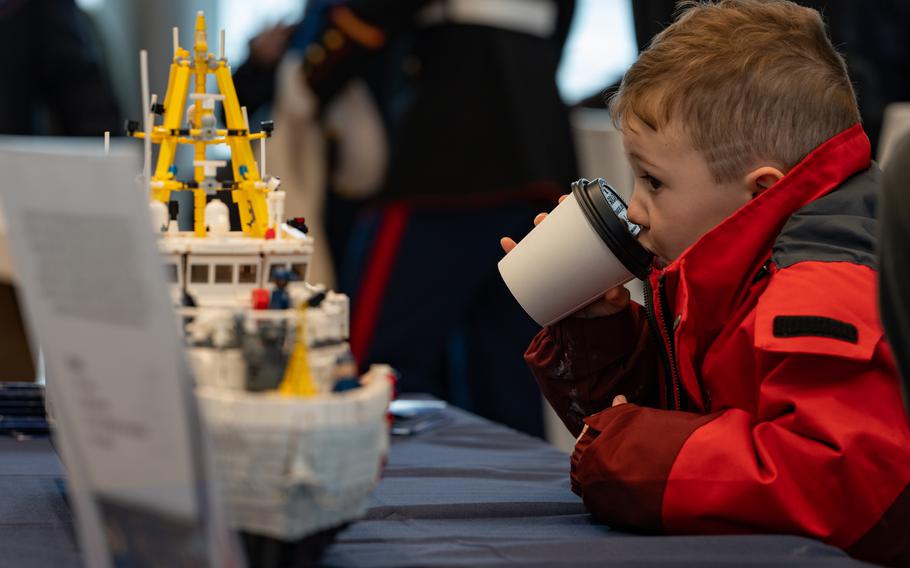
The U.S. Coast Guard commissioned CGC Melvin Bell at the Coast Guard Academy in New London, Conn., March 28, 2024. The cutter is named after Melvin Kealoha Bell, who distinguished himself during World War II by transmitting the first warning messages to military installations on the morning of the Pearl Harbor attack. (Matt Thieme/U.S. Coast Guard)
(Tribune News Service) — The crest of the newly inaugurated U.S. Coast Guard Cutter Melvin Bell bears a motto — ”Signal of Hope“ — that encapsulates the legacy of its Hawaii-born namesake who transmitted the first alarms following the attack on Pearl Harbor.
Melvin Kealoha Bell, a descendant of Kihaapiilani and the ruling chiefs of Maui who served as the first person of color to achieve the rank of Master Chief in the combined sea services, was honored at the Coast Guard Academy in New London, Conn., at the ship’s commissioning on March 28.
“He was an unknowing trailblazer,“ Robert Bell, Melvin’s son and historian, said Wednesday in an interview with the Honolulu Star-Advertiser. “He joined the service knowing that he would have to really work hard and have some things go his way in order to achieve his goal of becoming a radioman.”
Melvin Bell died in 2018 at the age of 98.
Born and raised on Hawaii island, Melvin Bell graduated from Hilo High School in 1938 before joining the U.S. Coast Guard at age 18, despite knowledge of systemic discrimination within the military’s structure. At the time, minority groups including Native Hawaiians and Pacific Islanders were being denied technical positions— instead often working in the mess branch as stewards or attendants.
Bell worked as a mess attendant when he enlisted, but in his off hours spent time around the radio room. Bell had previous experience in radio electronics, working under his father at the Hawaiian Telephone Company and at a small radio repair shop in Hilo. He had also taken vocational classes in school.

Robert Bell shakes hands with a crew member of the newly commissioned Coast Guard Cutter Melvin Bell at the Coast Guard Academy in New London, Conn., March 28, 2024. (Matt Thieme/U.S. Coast Guard)
“He knowingly joined the service with a plan. He had prepared himself well, going into the field of electronics, that if an opportunity presented itself, he would take full advantage of that, and then it would be up to those who had the power and influence to make a decision,“ Robert said of his father.
The next year, the opportunity presented itself — a radio transmitter aboard Bell’s ship wasn’t working properly, and no one could diagnose the problem. Bell asked if he could troubleshoot the problem and was able to repair the transmitter.
“Part of the procedure was the radioman had to call in to the district to report that the ship was back on the air. The individual on the other end was the chief radio electrician, and he said, ‘Who fixed the transmitter?,‘ and the radioman said, ‘Seaman Bell,‘ ” Robert said. “Since he didn’t know who that was, the chief radio electrician said, ‘Well, I want to meet this Bell.’ Those words essentially changed my father’s life.”

A child inspects a lego model of the newly commissioned Coast Guard Cutter Melvin Bell at the Coast Guard Academy in New London, Conn., March 28, 2024. (Matt Thieme/U.S. Coast Guard)
Bell would meet with Chief Henry Mumford Anthony the next day, where he was given the opportunity to test for the rate of radioman — exams he later “passed with flying colors.”
Bell would go on to work in numerous other positions, including at the Primary Radio Station Diamond Head, where he transmitted the first radio alarms of the Pearl Harbor attack. He also worked in Naval Intelligence with Fleet Radio Unit Pacific, and was part of the section that broke the JN25 code, supporting the victory at Midway in 1942. In 1958, Bell was promoted to the rank of Master Chief after a 20-year active duty career, becoming the first person of color to achieve the rank in combined sea services history.
In 1959, Bell took a civil service position with the Coast Guard in Honolulu, and worked for a combined 65 years of military and civil service until his retirement in 2004. He was honored by then-President George W. Bush for his “unprecedented 65-year federal career.”
“He was a diehard, fierce American patriot who loved this country and the United States Coast Guard,“ Robert said. “This is a man who began (working) prior to World War II, and ended doing work on munitions for Operation Enduring Freedom in Afghanistan.”
Robert said his father was “a very well-respected and humble man“ who was always willing to help others. Active in his church and as a volunteer in his communities, Robert said people would often see him and just stop to talk to him.
“He was a trusted associate and friend to all those he worked with. He was just very well-liked. He was the type of man that you could count on,“ Robert said. “Those are the traits that helped him in his early life to achieve the things that he did.”
Robert said that his father didn’t speak much of the things he did throughout his life, but that when he began to learn about his father’s accomplishments, it was “necessary that the Coast Guard know his story.”
“My dad was the type of man that was very quiet and very humble, very reserved throughout his life,“ Robert said. “As children, we had an idea of some of the things which he had participated in, like Pearl Harbor and other things like codebreaking, but I didn’t really know that much about his life until I started to sit down with him the last 30 years of his life and interview him and talk about him to document his life story and his history.”
In 2014, a Coast Guard historian interviewed Bell for publication on the Coast Guard’s oral history website.
More accolades soon followed. In 2020, the electronics support facility at the U.S. Coast Guard Base at Sand Island was named the Master Chief Melvin Kealoha Bell building. In 2022, the Smithsonian National Museum of the American Indian recognized Bell as the Native Hawaiian representative in their “Why We Serve“ exhibition, honoring Indigenous veterans. A portrait of Bell also hangs at the residence of the Commander of the 14th District at Diamond Head Lighthouse.
“He will be an example of success to people of all minorities that you can achieve if you work hard enough to make it happen,“ Robert said. “He is fully deserving of all the honors he’s receiving now.”
Over 80 members of the Bell family attended the commissioning ceremony in New London, Conn. — something Robert said was “very heartwarming.”
The $45 million USCGC Melvin Bell is the 55th of 65 Sentinel-class ships ordered by the Coast Guard to replace 1980s-era patrol boats. The fast-response 154-foot multimission cutter will be moored in Boston, and will sail on its first mission later this month.
The ship is powered by two marine diesel engines, and includes advanced communications, surveillance and reconnaissance abilities. It has four 50-caliber machine guns and one 25mm automatic cannon. It will be operated by a crew of four officers and 20 enlisted personnel, who spent the last year training on the ship.
“He’ll be remembered forever. After we’re long gone, that ship will still be floating in the water,“ Robert said. “This ship means more than the materials it’s made out of. The individuals now who are the crew of the ship, they are taught about the namesake of the vessel which they serve on, and they are trying to live up to the expectations that he would have set for himself as they serve the nation.”
BY THE NUMBERS
Length, 154 feet.
Beam (width) 25 feet.
Draft, 9 feet, 6 inches.
Displacement, 353 long tons.
Maximum speed: 28+ knots.
Range: 2,500 nautical miles.
(c)2024 The Honolulu Star-Advertiser
Visit at www.staradvertiser.com
Distributed by Tribune Content Agency, LLC.